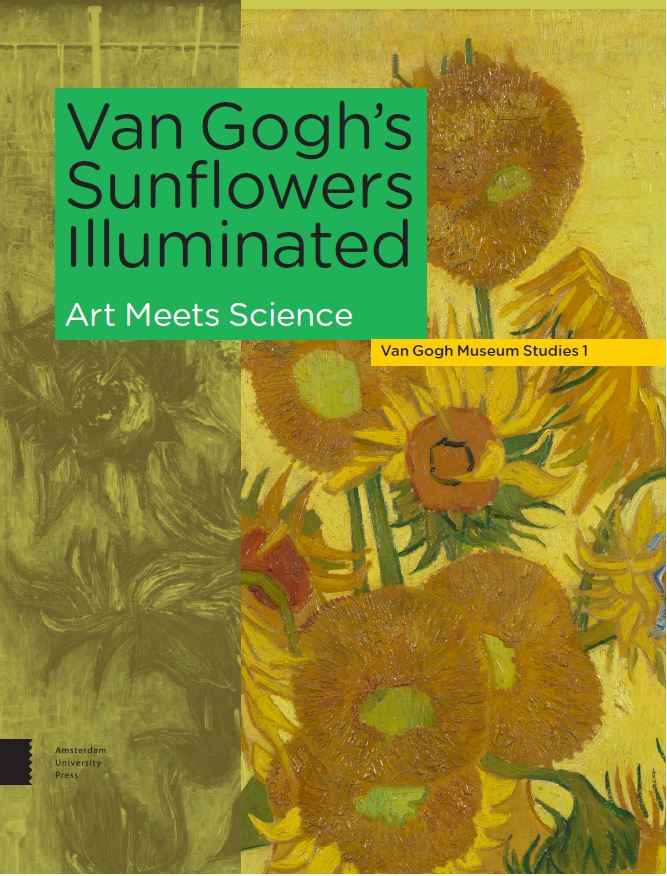
Vincent Van Gogh’s Sunflowers Illuminated is a scientific publication by the Van Gogh Museum in Amsterdam (Amazon.com, Amazon.co.uk, Amazon.fr, Amazon.de), which is known for its interdisciplinary approach.
The book is entirely devoted to the research performed over the years into Van Gogh’s Sunflowers, an icon of Western European art. The artist painted five large versions of the same subject and this publication focuses on two of them in which the vase with sunflowers is portrayed against a yellow background: the first study painted from life in August 1888 (in the collection of the National Gallery in London), and the version made in January 1889 (in the Van Gogh Museum in Amsterdam).
New information recently came to light when the two paintings were examined in unprecedented depth using a broad array of traditional and state-of-the art techniques to look closely at and underneath the paint surface. Van Gogh’s Sunflowers Illuminated presents the outcome of this research undertaken by an international team of more than 30 scientists, conservators and art historians who have contributed as co-authors to this volume.
Ella Hendriks initiated the research into Sunflowers as Senior Paintings Conservator at the Van Gogh Museum. Following her appointment as Professor of Conservation and Restoration of Moveable Cultural Heritage at the University of Amsterdam, she has remained the central figure in both the ongoing study and the production of this book.
Van Gogh’s Sunflowers Illuminated puts the artist’s sunflower artworks in perspective. Van Gogh painted a total of eleven canvases of sunflowers: four in Paris and seven in Arles. This chapter sketches the genesis of the series, focusing on the five large sunflower still lifes that he painted during his stay in Arles.
The book examins the methods, materials and condition of the National Gallery London and the Van Gogh Museum Amsterdam Sunflowers, covers the chemical alteration and colour changes in the Amsterdam Sunflowers painting, analyzes the structure and chemical composition of the surface layers in the Amsterdam Sunflowers are analyzed, and deals with the conservation of the Amsterdam Sunflowers.
One chapter describes the outcome of the technical examinations of the Amsterdam Sunflowers, characterizing the surface layers present and assessing the history of application as revealed by their stratigraphy and chemical composition. The proposed stratigraphy and chemical composition of the varnish layers and alteration products is based on the results of visual observation of the surface through light microscopy and non-invasive analysis in 44 areas of the painting using optical coherence tomography (OCT) and reflection Fourier transform infrared (FTIR) spectroscopy, both accessed through MOLAB (EU-project IPERION CH). The results obtained with these techniques are substantiated by information obtained using light and UV-induced fluorescence microscopy on a total of 16 paint cross-sections taken from 12 different locations on the painting, 14 of which show organic surface layers. The composition of the varnish layers and paint alteration products on Sunflowers was investigated using attenuated total reflection Fourier transform infrared (ATR-FTIR) imaging and reflection micro-FTIR on a selection of the available paint cross-sections. Furthermore, mass spectrometry (MS) techniques were applied to individual varnish samples. These included direct temperature-resolved MS (DTMS) and gas chromatography MS (GC-MS).
Towards the end, the book offers an overview on research methods and technical terms as well as information regarding the experimental methods and conditions used for investigating the Amsterdam Sunflowers and mock-up paints.
In short, this book gets at times very technical. Therefore, the Van Gogh Museum in Amsterdam offers a publication easier to read: Van Gogh and the Sunflowers. Alternatively, you can focus on the roughly 25-page chapter “The Sunflowers in Perspective” in the scientific Van Gogh’s Sunflowers Illuminated, where art historians explain that Van Gogh’s stay in the south of France in 1888–89 was the most intensely creative period of his brief life. In Arles, he created some 200 paintings. The chapter also deals with the ambition that led him there, his friendship and falling out with Paul Gauguin, his parlous mental health, breakdown and commitment to an asylum where, between August 1888 and January 1889, he painted seven Sunflowers canvases.

Van Gogh’s Sunflowers Illuminated: Art Meets Science, the first volume in the Van Gogh Museum Studies series. Amsterdam University Press, June 2019, 256 pages with many illustrations (artworks + scientific illustrations). Order the book from Amazon.com, Amazon.co.uk, Amazon.fr, Amazon.de.
Related English articles: Van Gogh and the Sunflowers, The Thannhauser Gallery: Marketing Van Gogh, Van Gogh: On the Verge of Insanity, Munch : Van Gogh, Gauguin: Portraits, The Paul Gauguin exhibition at Fondation Beyeler.
For a better reading, quotations and partial quotations from the book reviewed here are not put between quotation marks.
Book review added on June 11, 2020 at 16:41 Amsterdam time.